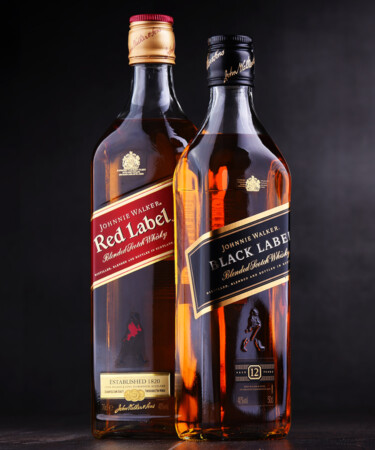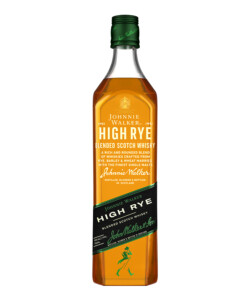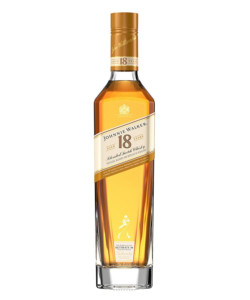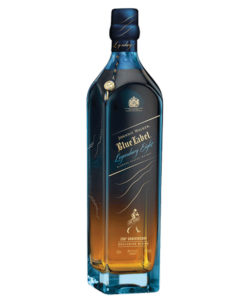If you are a Scotch drinker, you’ve had or at least heard of Johnnie Walker. It’s the square bottle with the slanty label and the guy with the hat sort of strutting like he’s Staying Alive.
And it’s in fact a damn fine whisky, blended with grain except for the Green Label “vatted malt,” And something nobody will be upset with if you bring it to a party. No one turns down Johnnie. If you bring these facts as well, you’ll be even more of a hit.
Johnnie Walker is the most popular Scotch in the world.
If the world of Scotch whisky was a high school, Johnnie Walker would probably win all the superlatives. (Not sure about “Best Hair.”)
Johnnie Walker is indeed named after a dude.
Maybe it’s no longer exciting that many older brands had names (real names) behind them. But then again, we live in an era of Pepsi and Twitter and, as far as we can tell, there’s no such person as John or Charles or Veronica Twitter. So the fact that Johnnie Walker was an actual person is still pretty cool.
John Walker was a young farmer.
And he grew up on a place called Todriggs. He actually had to sell the farm after his father’s passing to open his first grocery in Kilmarnock. If John Walker hadn’t set up his shop, Kilmarnock might have stayed a whole lot less famous. Not necessarily a bad thing. (Be careful. That links to a poem.)
Johnnie Walker started at John Walker’s grocery.
Most whiskies at the time were found in general groceries, meaning you could buy stuff like flour and hard liquor in the same trip. Johnnie Walker was no different, sold in its first years out of the family grocery store in Kilmarnock, a town in Scotland not too far from its western coast.
Johnnie Walker whisky began as a reaction to single malt.
Single malt may be prized for good reason today, but back in the 19th century, consistency was more of a tricky issue. John Walker wanted a consistent Scotch and so he turned his store brand into a blend. (Just a quick reminder, single malts are the product of one distillery, blends are blends from many distilleries.)
The overall flavor profile is intriguingly contradictory.
Johnnie Walker is a smooth whisky, no doubt, but that doesn’t mean it lacks staggeringly awesome/annoying/sit-down-for-a-long-thoughtful-sip complexity. In the 12 Year, for instance, you’ll get dark chewy toffee and spice on the nose but lighter hits of citrus, garden patch, and delicate grain once you knock it back.
The original bottles didn’t say “Johnnie Walker” or show someone strutting.
Like many vintage whisky items, older Johnnie Walker bottles—full or empty—are on sale. One seller advertises a bottle that reads “John Walker and Sons,” plus some legal stuff etched into the bottle about how “federal law forbids sale or re-sale of this bottle.” Apparently that law no longer applies? Or the seller is just badass.
The “walker” on the label was originally a doodle.
A very good doodle. Tom Browne was a renowned “illustrator of the time” and he drew a picture of the “Striding Man” during lunch one day. The Johnnie he drew has evolved into a sleek and mysterious dude, but back in the day he was a lot more colorful and friendly. (See the label in the top photo. It also kind of looks like he’s talking on a cellphone? Did the artist have ESP?)
The label is slanted on purpose.
Alexander Walker took over operations after his father John’s passing, and among the several things he did to help the family’s Scotch stand out from the growing whisky crowd was slanting the label precisely 24 degrees.
The “color” identification didn’t come until much later.
We’ve all knocked back a bottle of Johnnie Walker Red. Right? Well, anyway, the bottles weren’t labeled by color until Alexander Walker passed the business onto his sons and they started identifying the different blends this way. Johnnie Walker Blue is still the stuff you have to hide from anyone not worthy, but there are also now Gold and Platinum labels.
Speaking of the colors, they do mean different things.
The Red is a blend that was created for a specific drink (see below). The Black is peatier than the Blue but also not as smooth. There’s also a Double Black that just refers to more smoke (an effort to recreate peat-heavy single malts), and the iconic, sought-after Blue, rich and smooth and alluringly complex, like Ewan McGregor in pretty much every movie.
Johnnie Walker “Red” was initially meant to mix.
Not that you can’t drink it straight. But Johnnie Walker Red was apparently created to be “more suited to mixing with soda” than heavier Scotches. And yes, Scots mixed (some) of their whiskies with soda.
There is a $22,000 bottle of Johnnie Walker.
Actually, it’s $22,577.44. (If you can’t come up with those 44 cents, we’re wondering if they’ll cut you a break?) It’s a blend of 45- to 70- year-old whiskies, a celebration of the company’s legacy, and—put that giant briefcase of cash away—“generally not for sale.”
How Much Does Johnnie Walker Cost?
| Type | U.S. Price | Description |
|---|---|---|
| Johnnie Walker Red Label | $22.99 – $24.99 | Johnnie Walker Red is a blended Scotch with a color reminiscent of honey. Made from a mix of grain and malt whiskies from different distilleries, its aromatic nose has notes of black pepper and spice. |
| Johnnie Walker Black Label | $29.99 – $32.99 | Johnnie Walker Black Label is a blended Scotch made from single malt and grain whiskies. Its flavor profile includes woody undertones with notes of spice and creamy toffee. It can be sipped neat or over ice, but is ideal in a classic Highball. |
| Johnnie Walker Green Label 15 Years | $59.99 – $69.99 | Made from single malts sourced from four different regions in Scotland, Johnnie Walker Green Label 15 Years is a blended Scotch that is aged for 15 years in oak casks. Johnnie Walker Green Label 15 Years has notes of chocolate and wood on the nose; spice, nuts, and fruit on the palate; and a long, spicy finish. |
| Johnnie Walker Blue Label | $150.99 – $180.99 | The Blue Label is Johnnie Walker’s most premium offering and is blended from several rare whiskies that range in age and distilling location. It has a smooth yet smoky taste that is rich in caramel and chocolate notes. |



